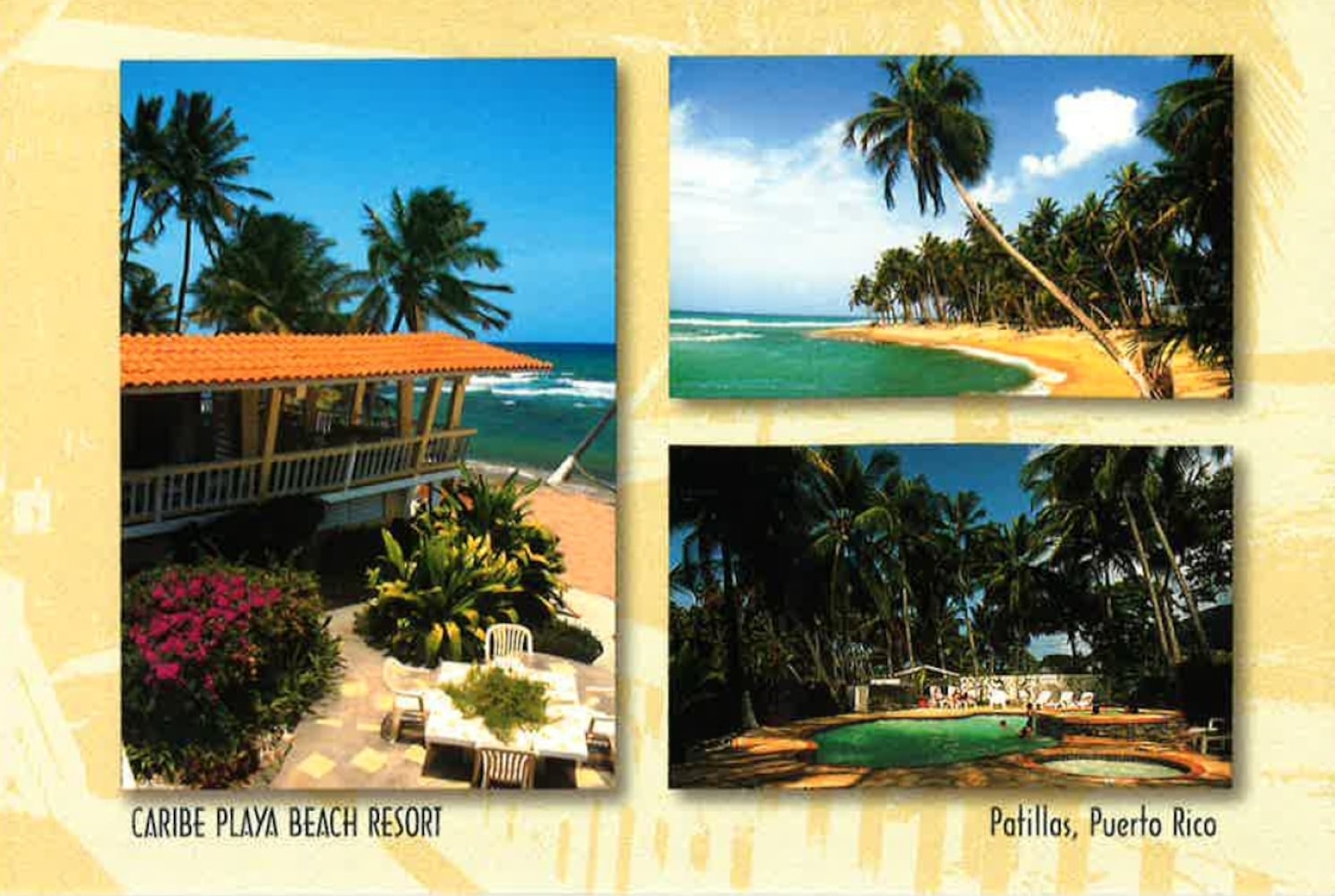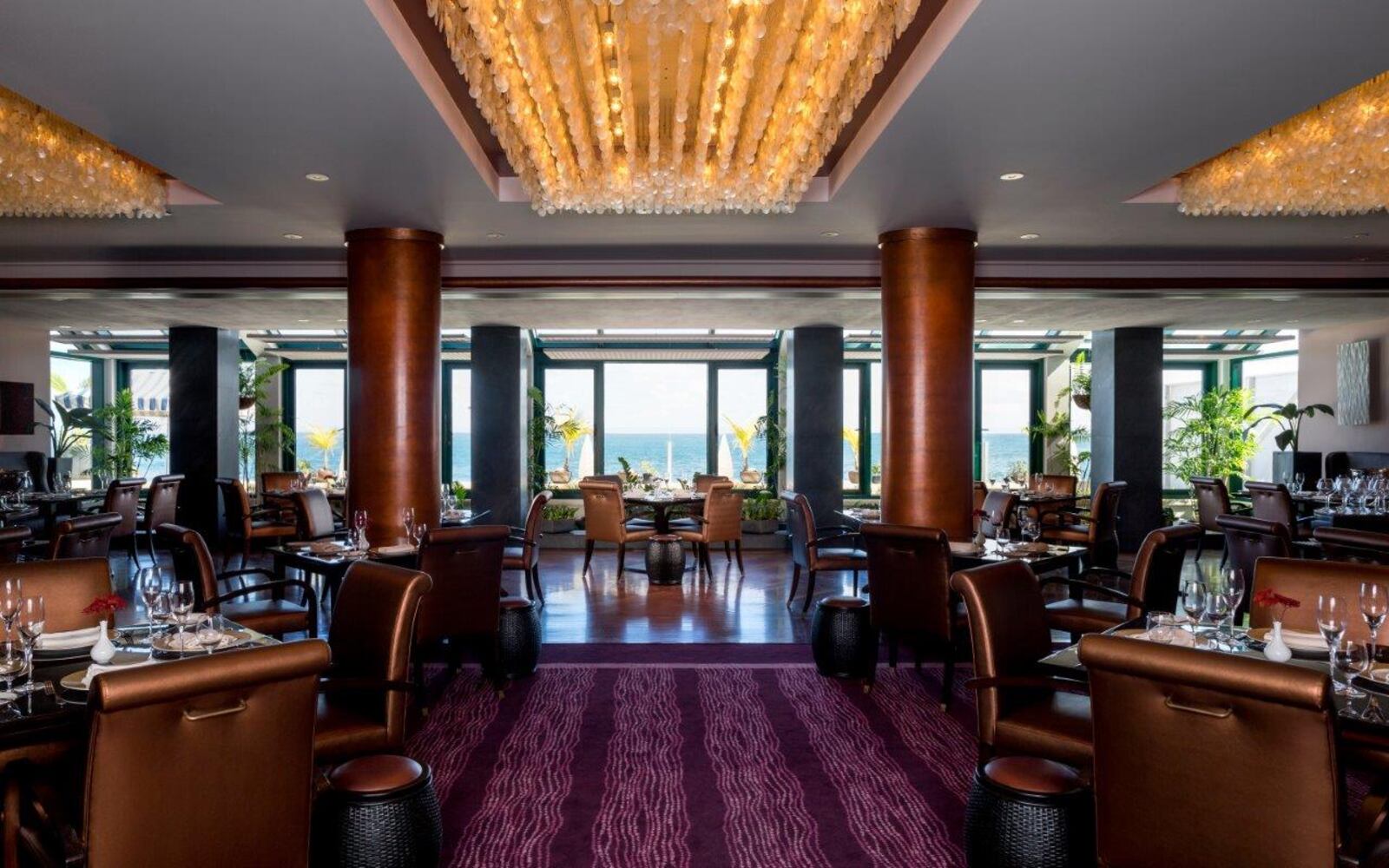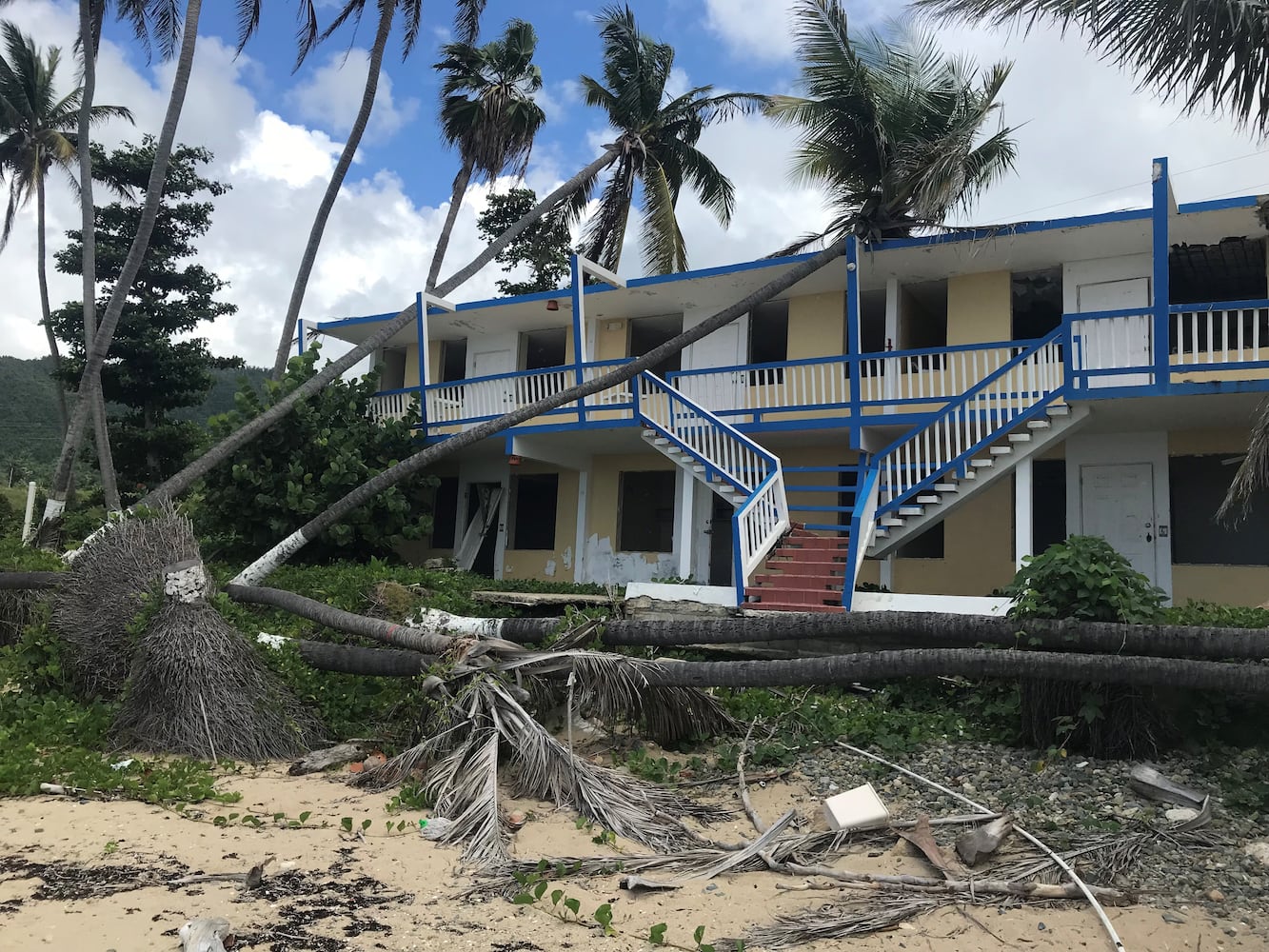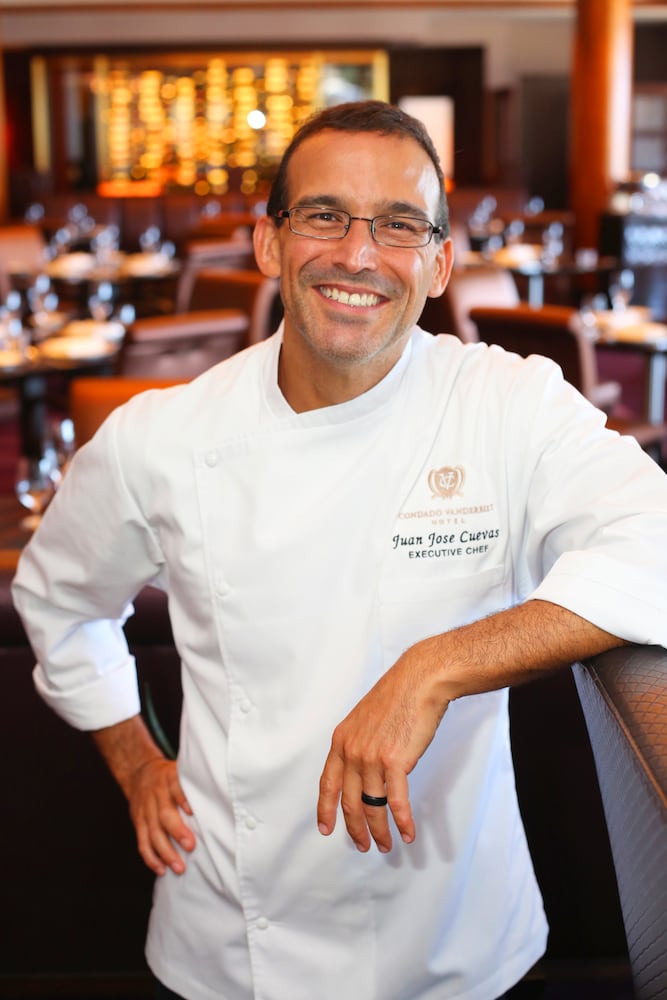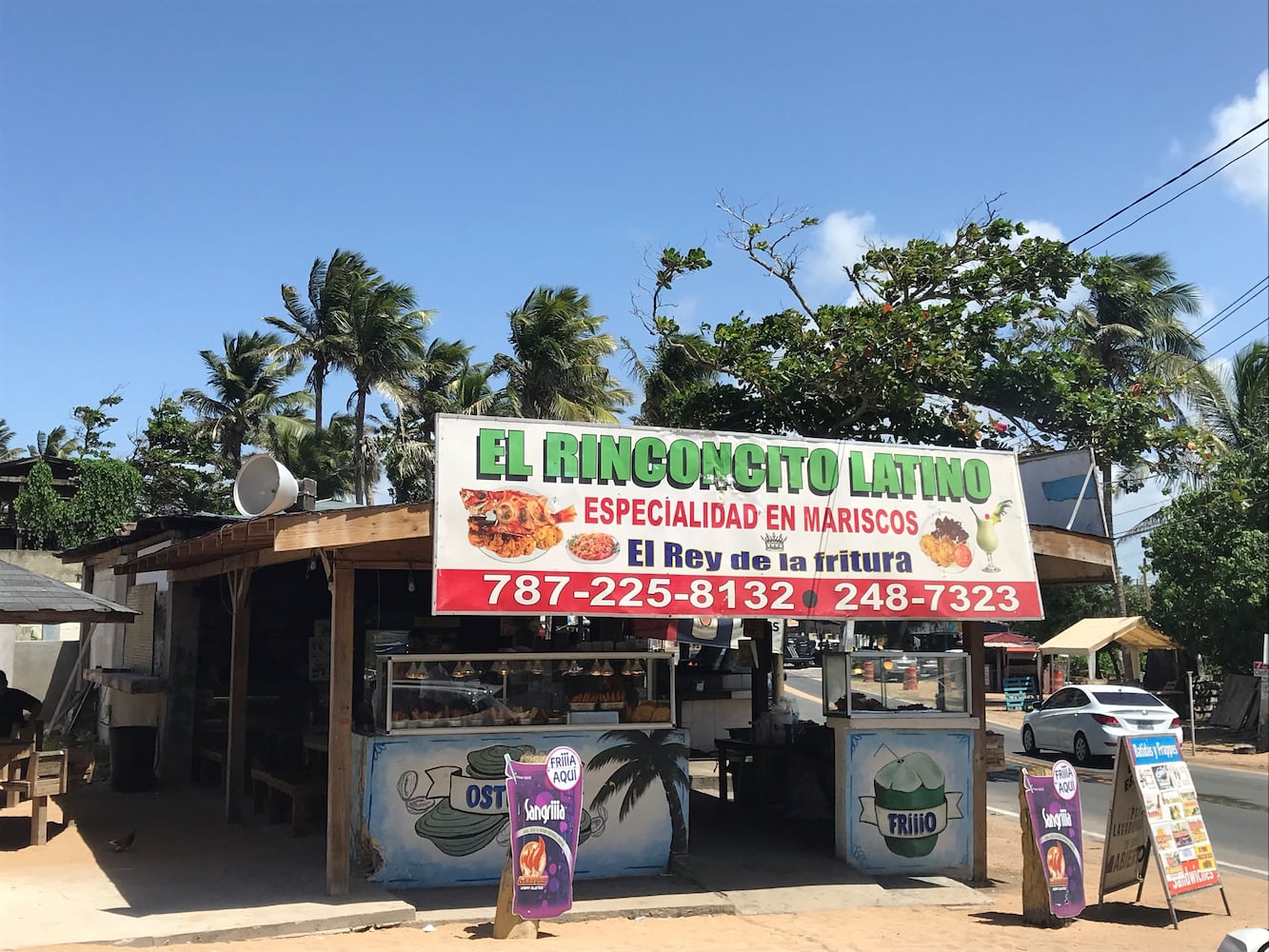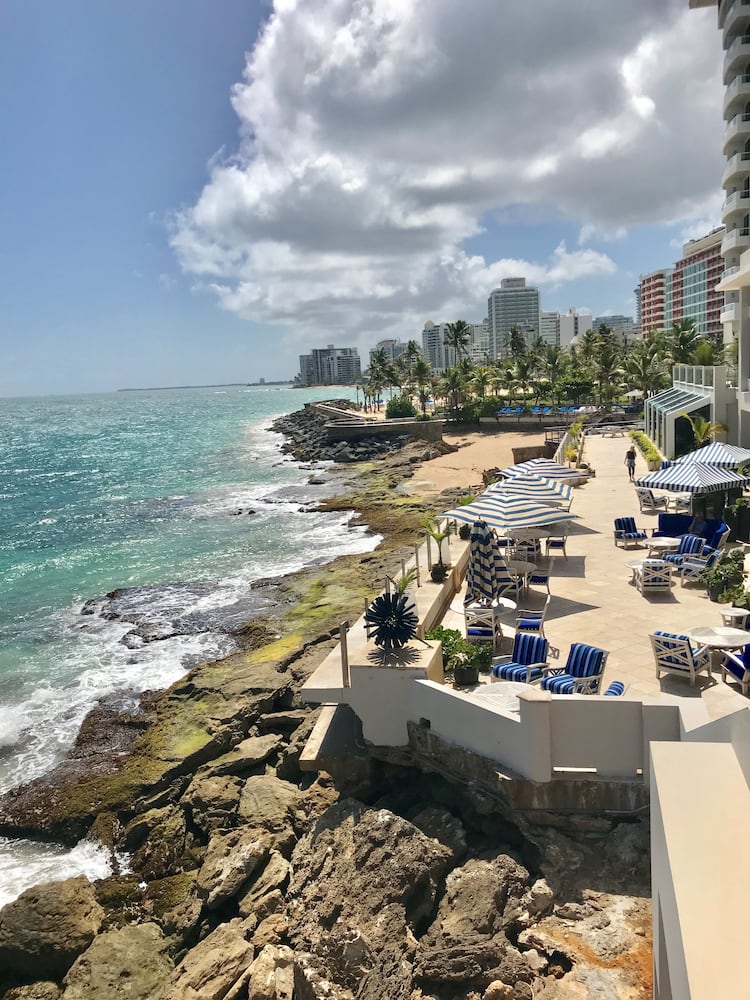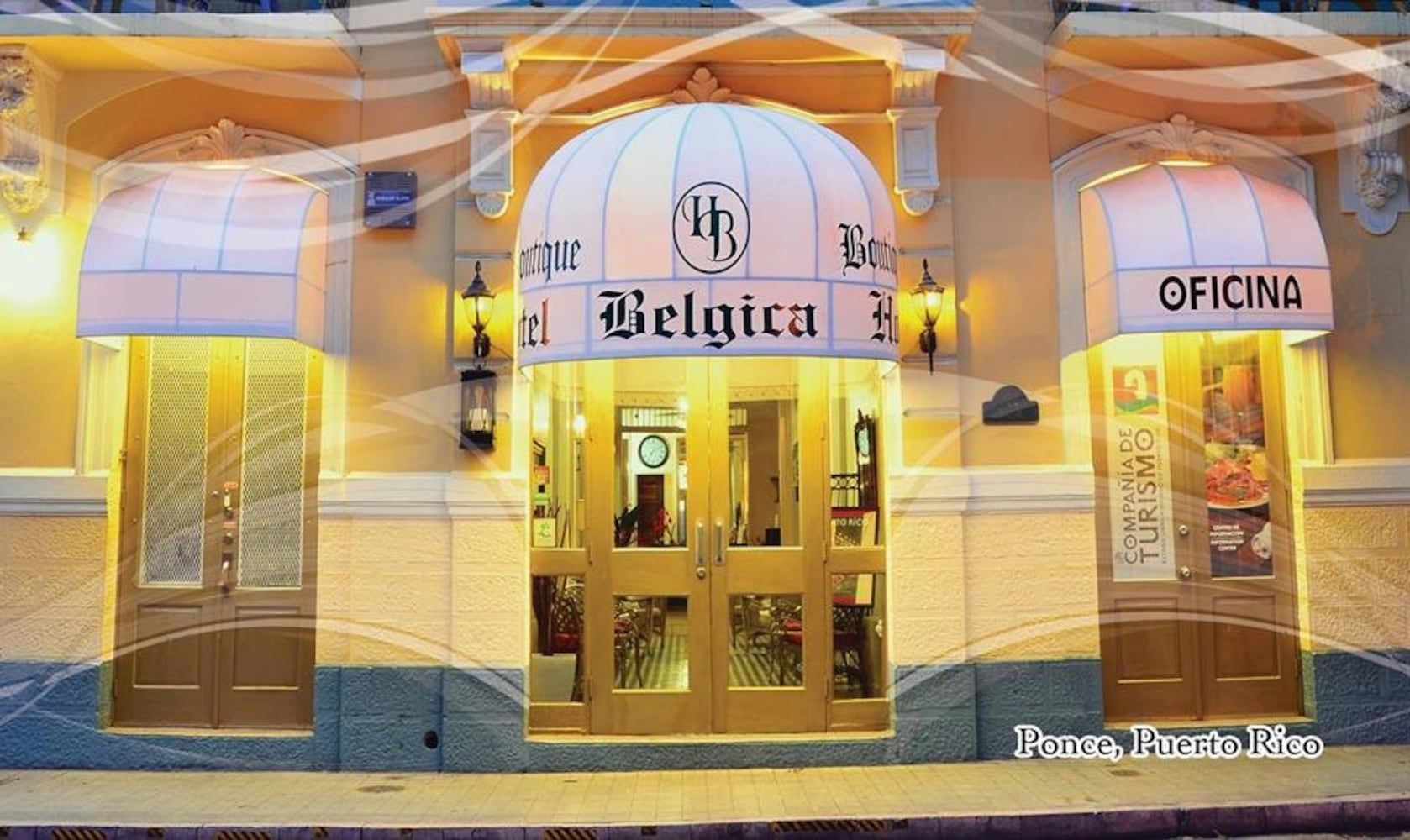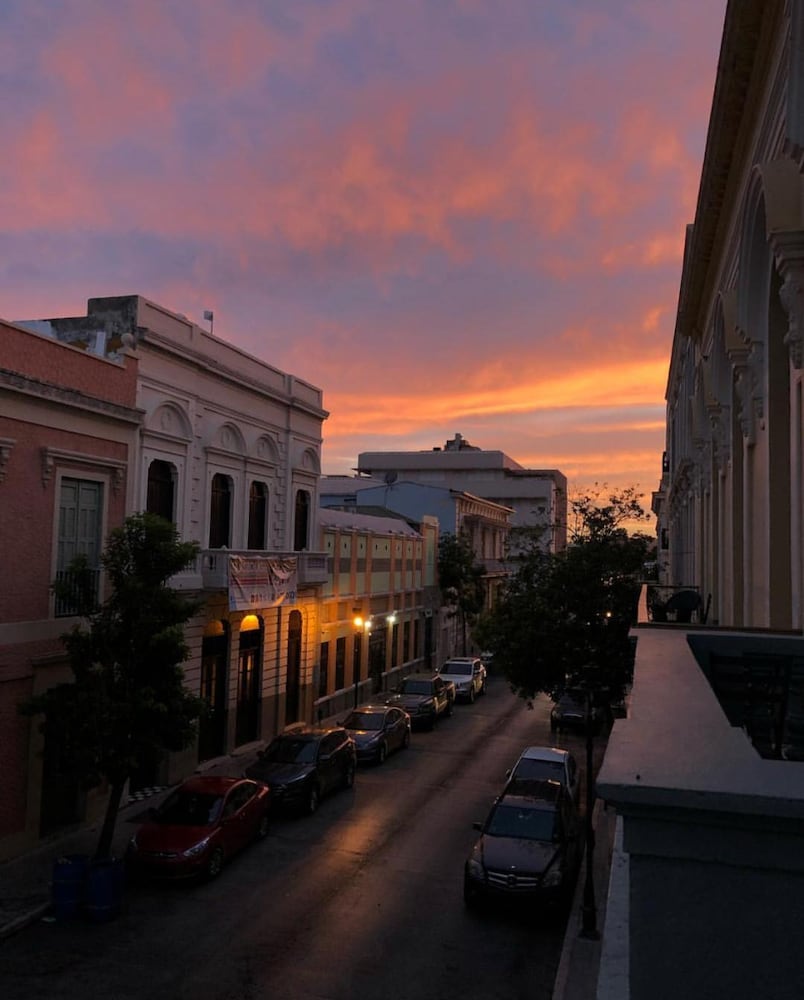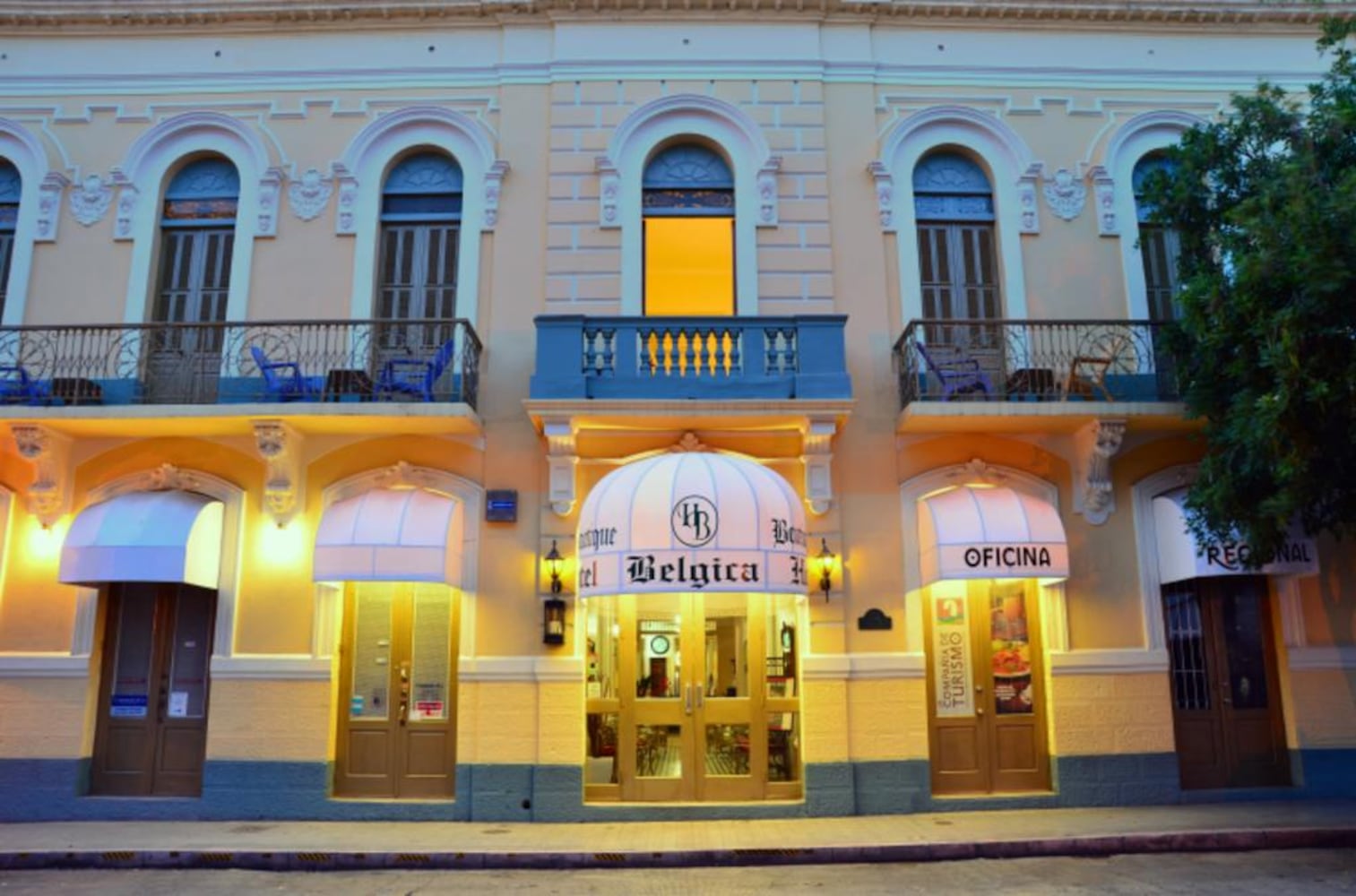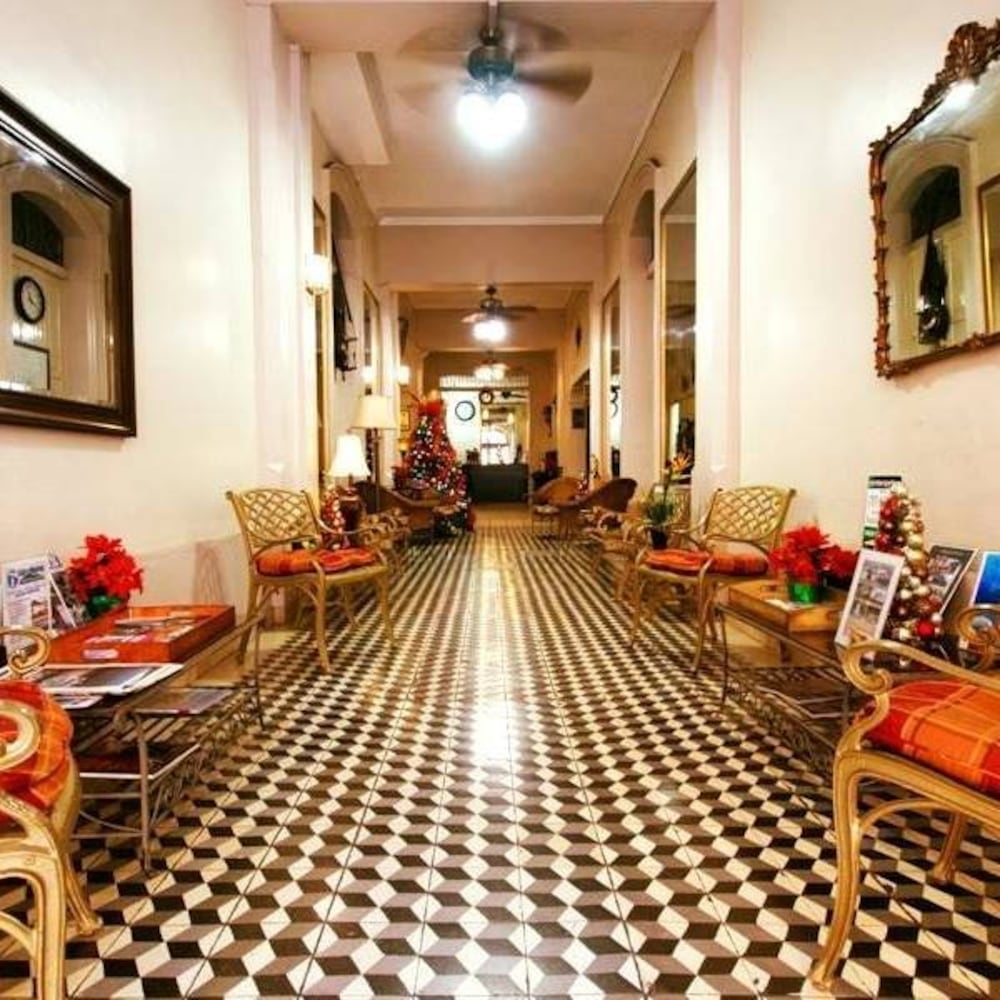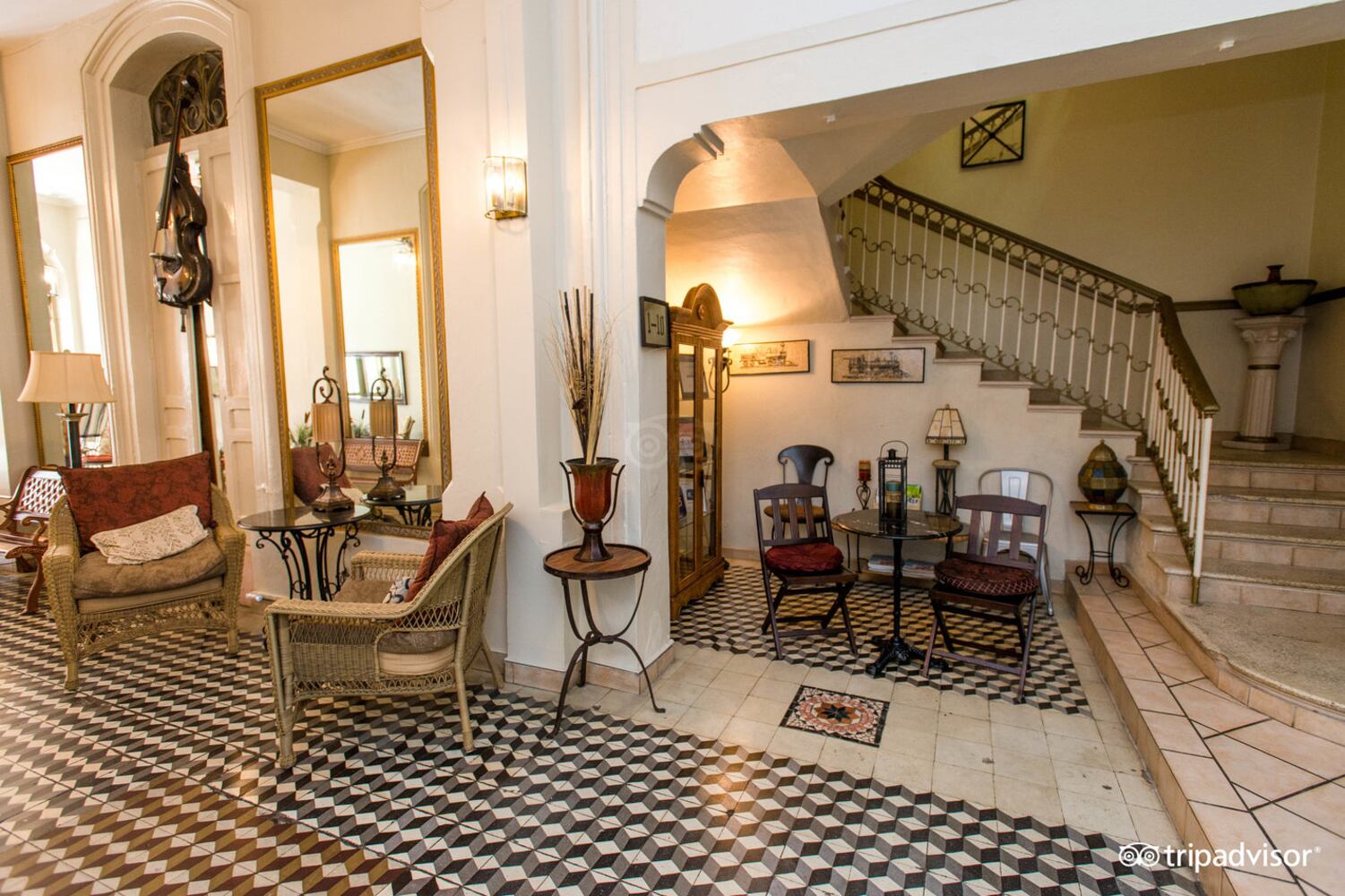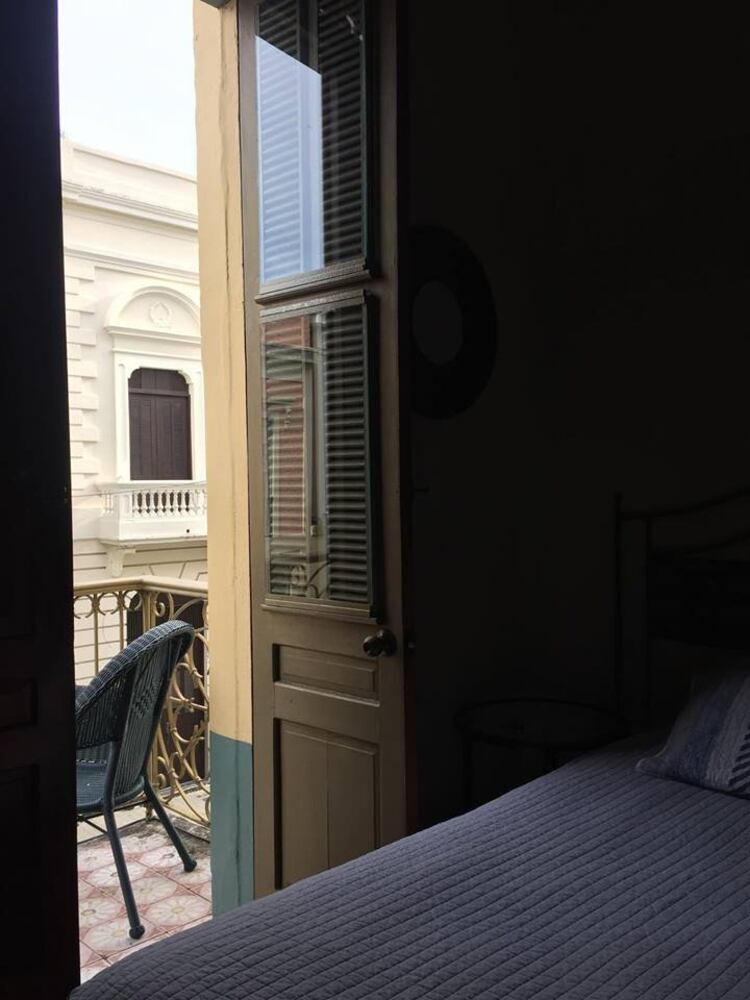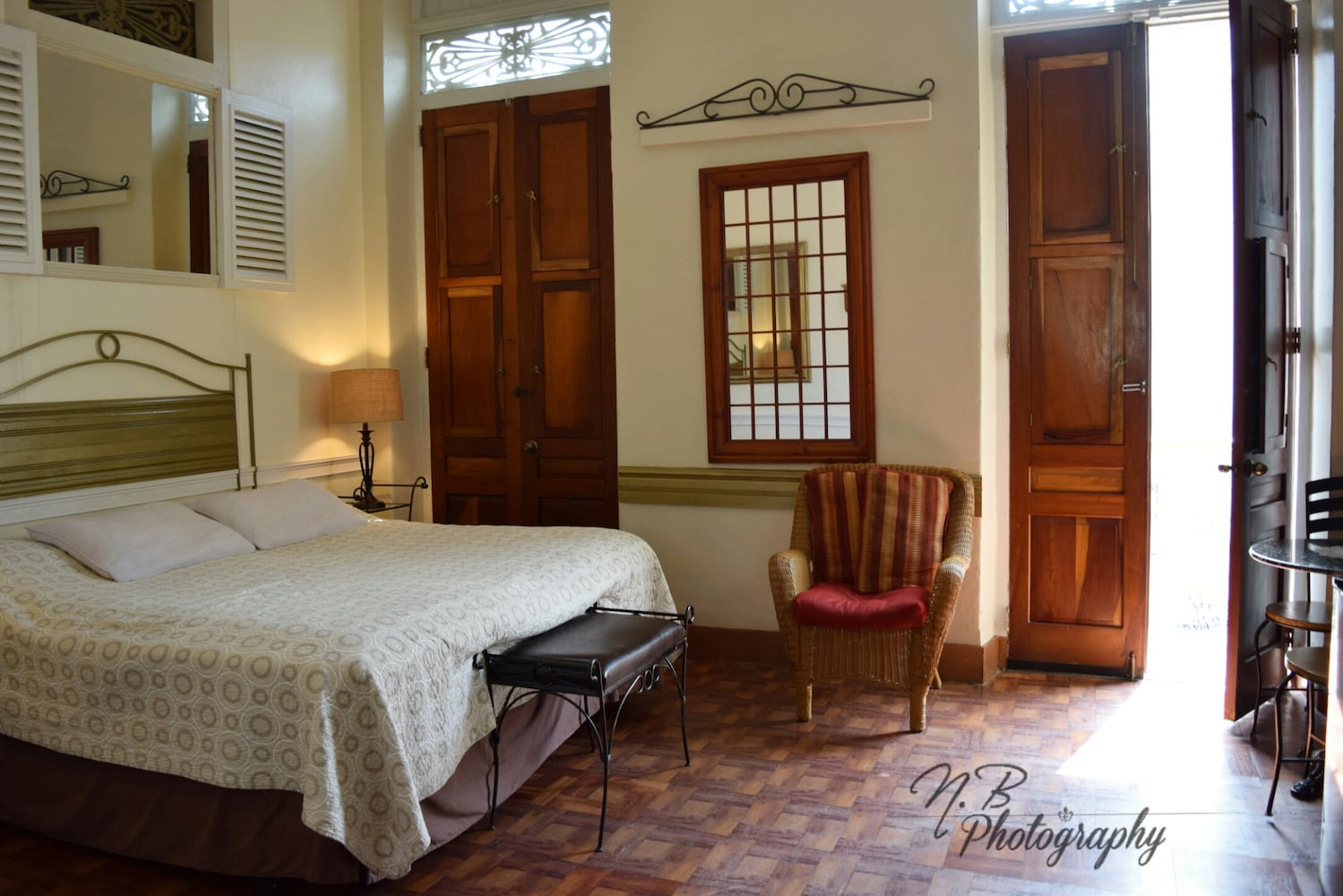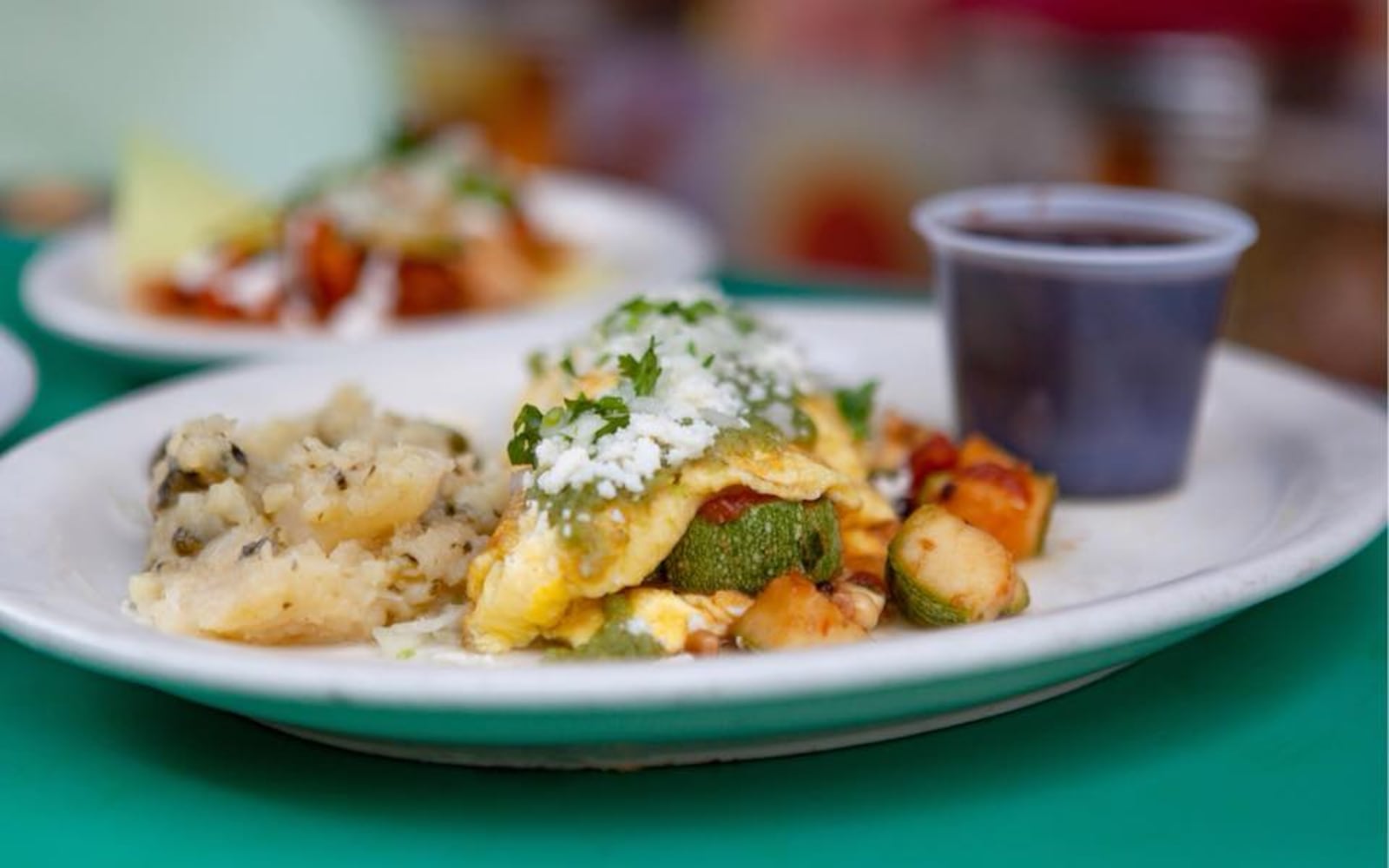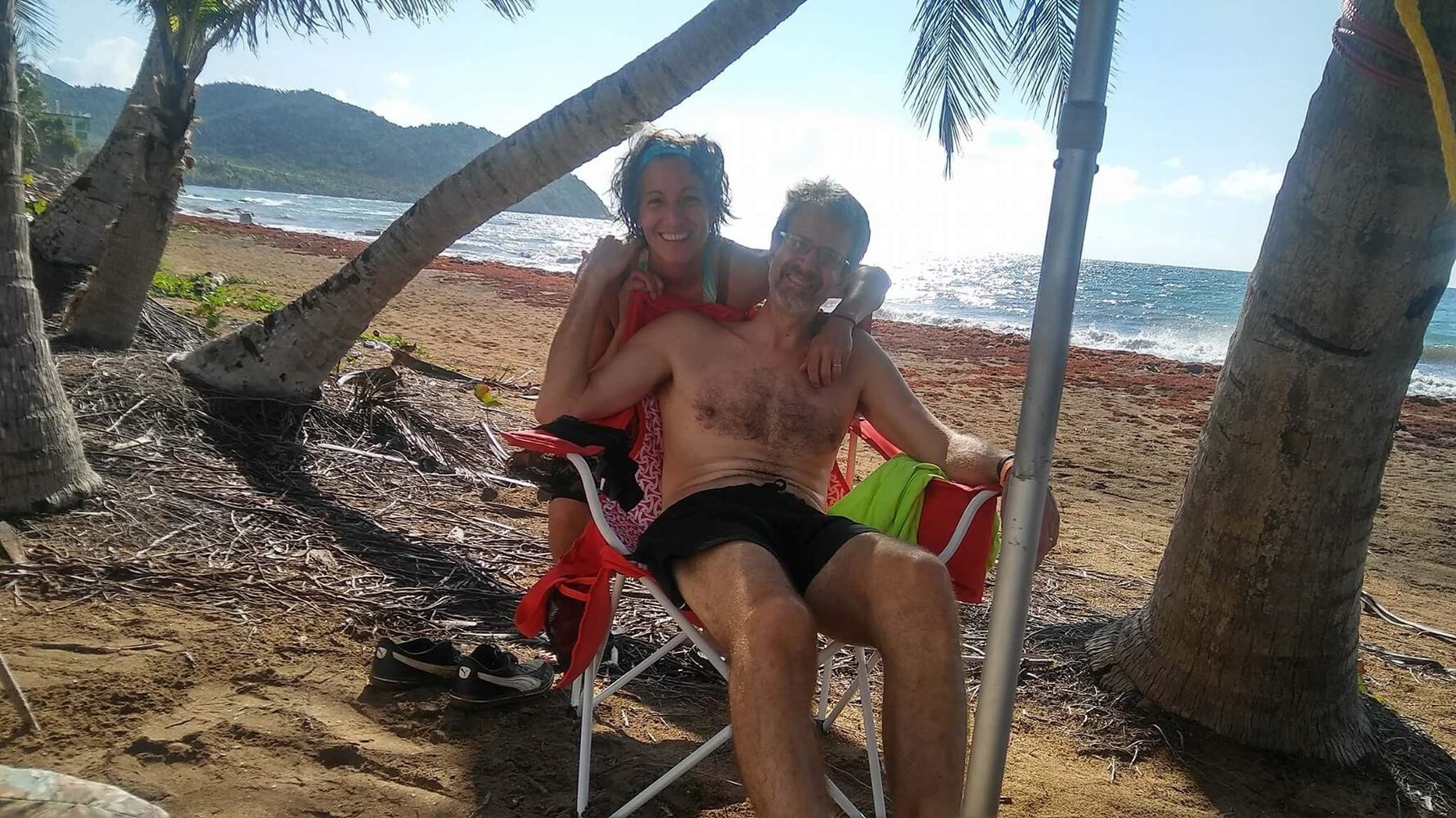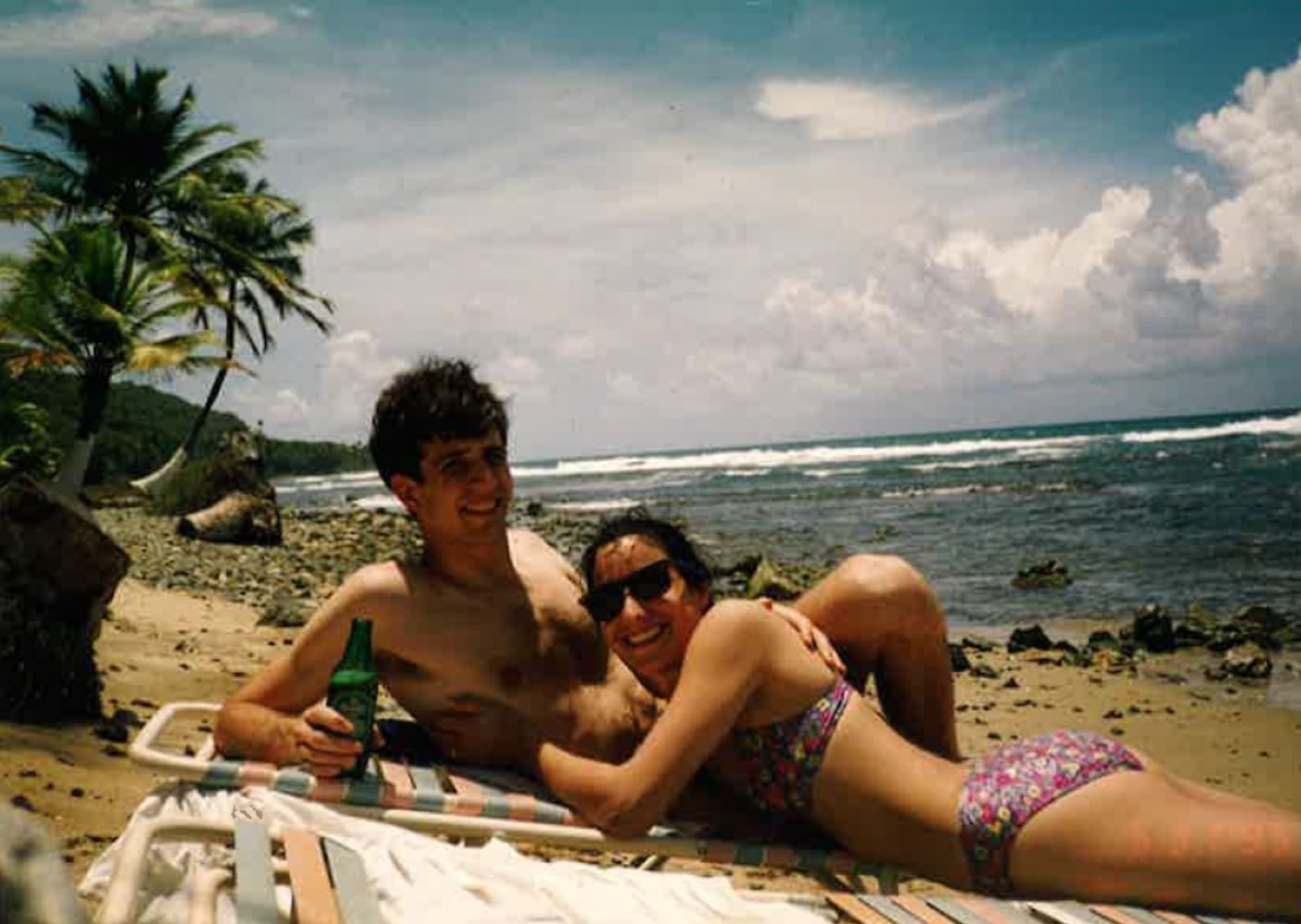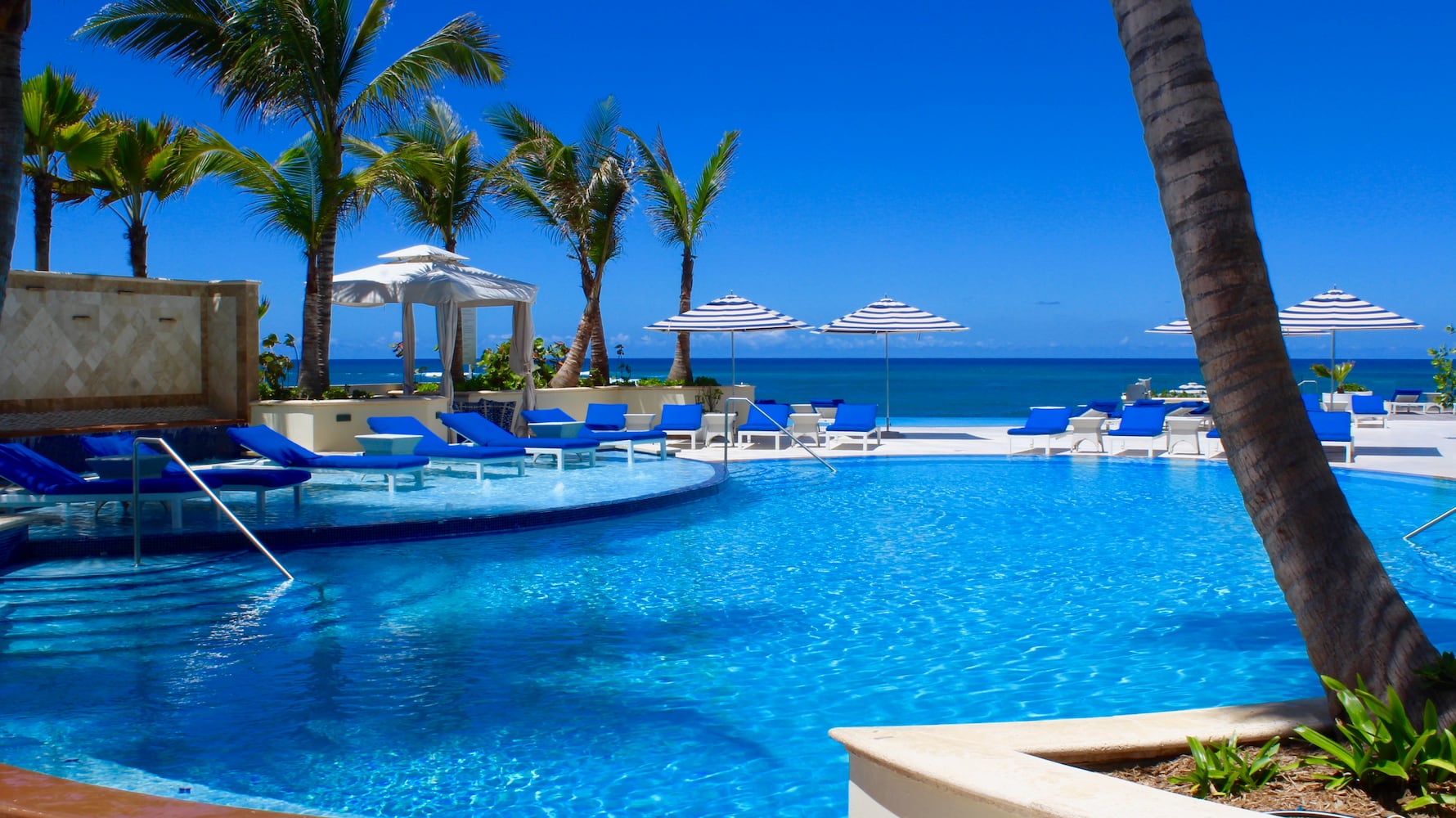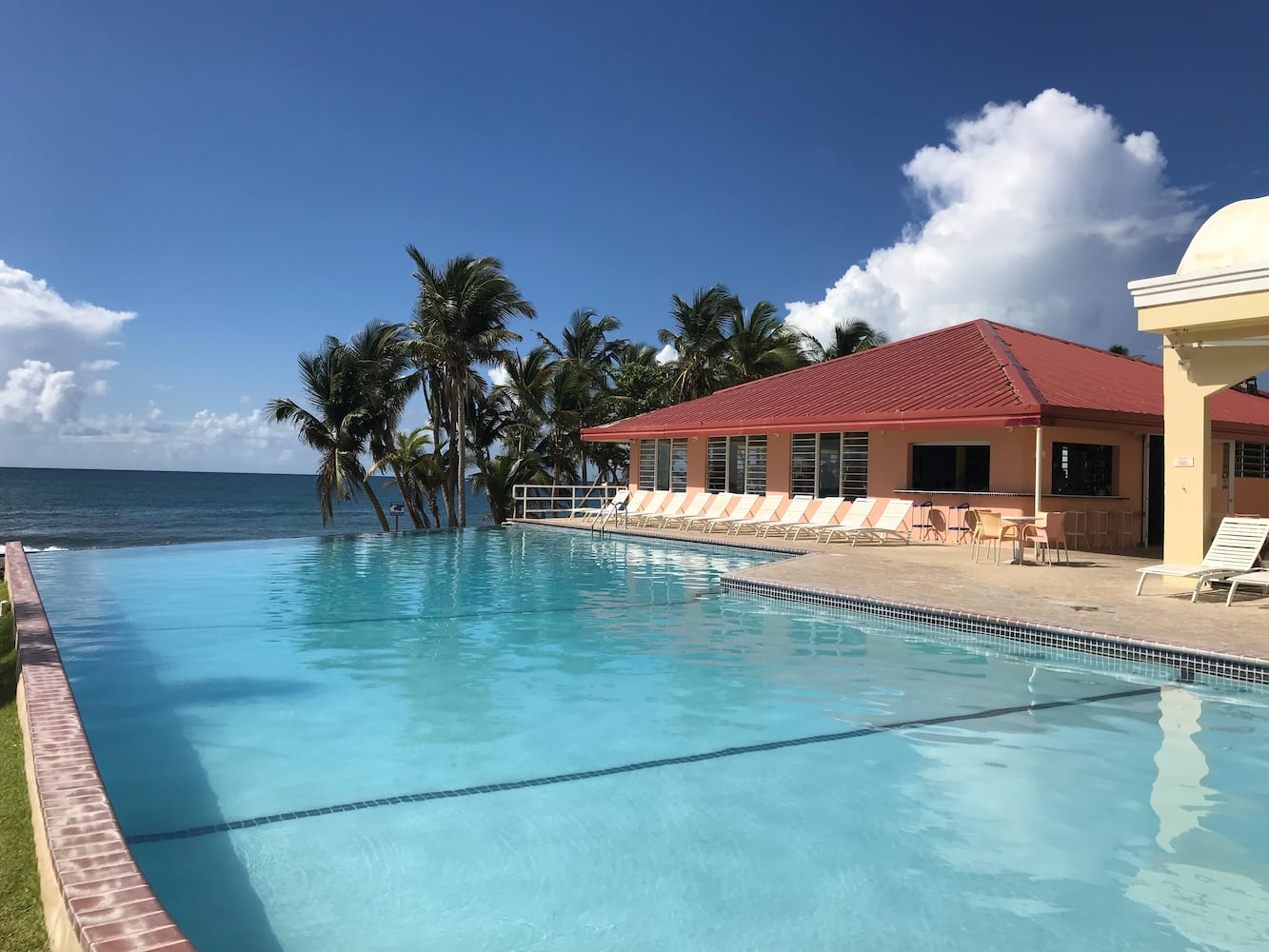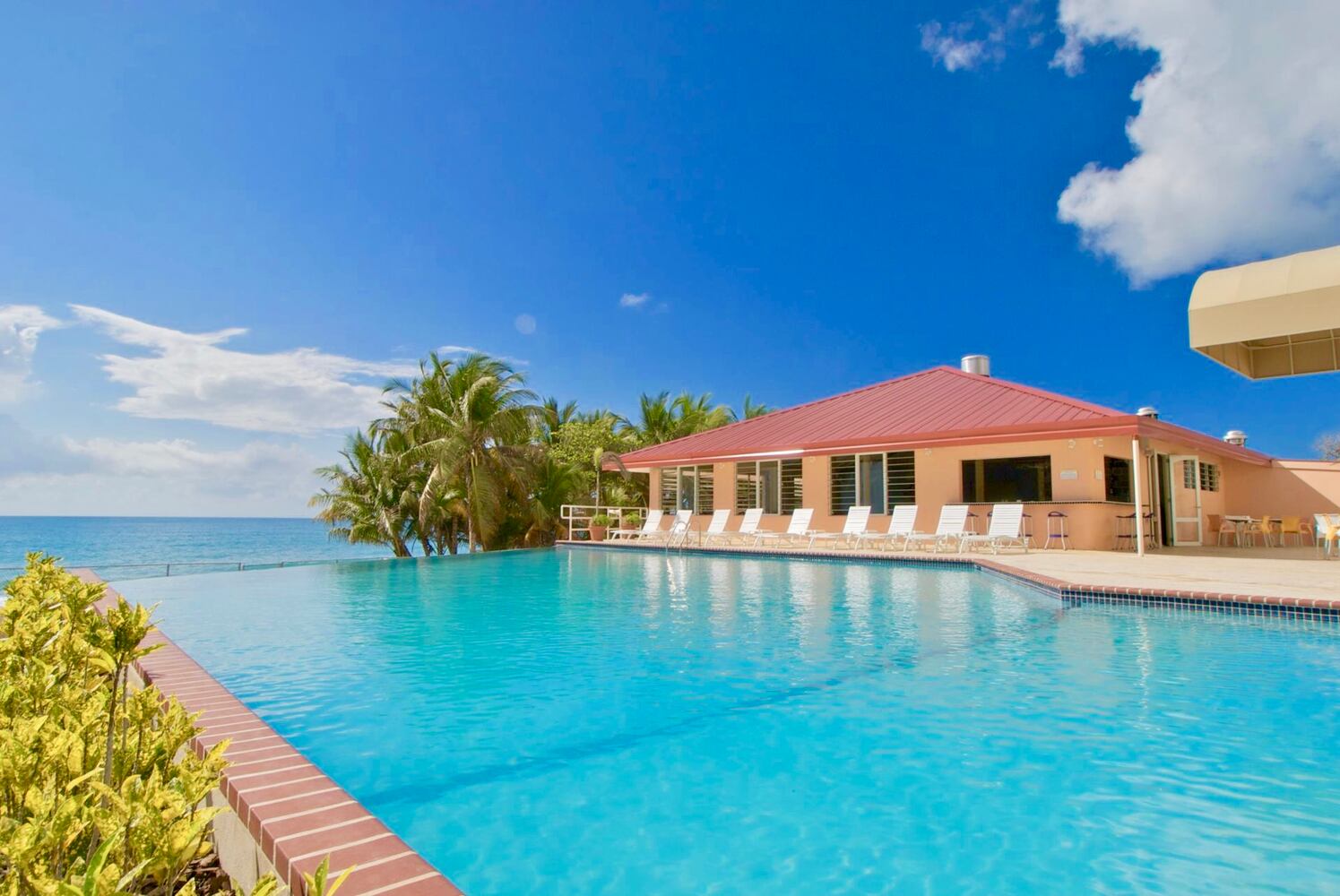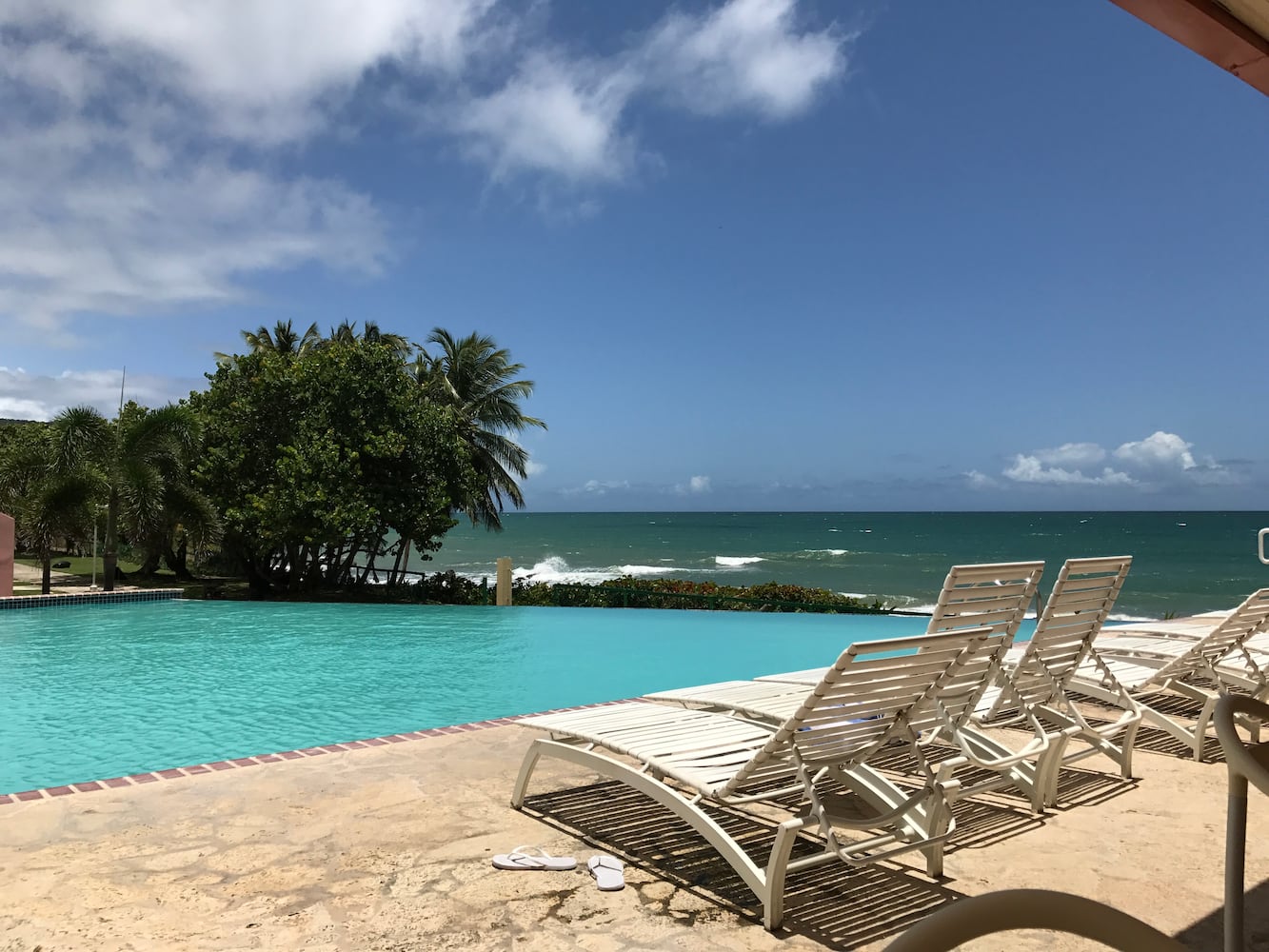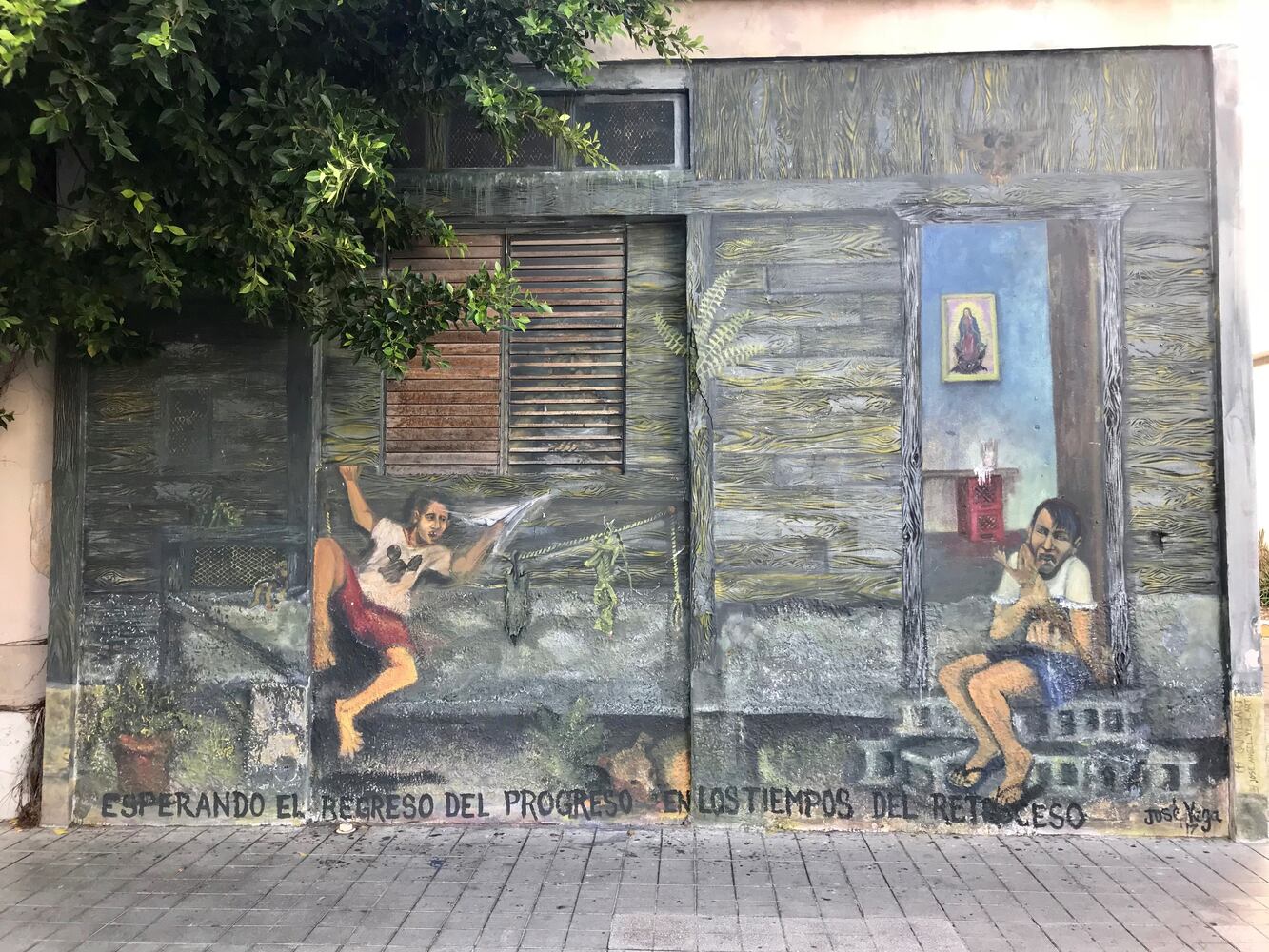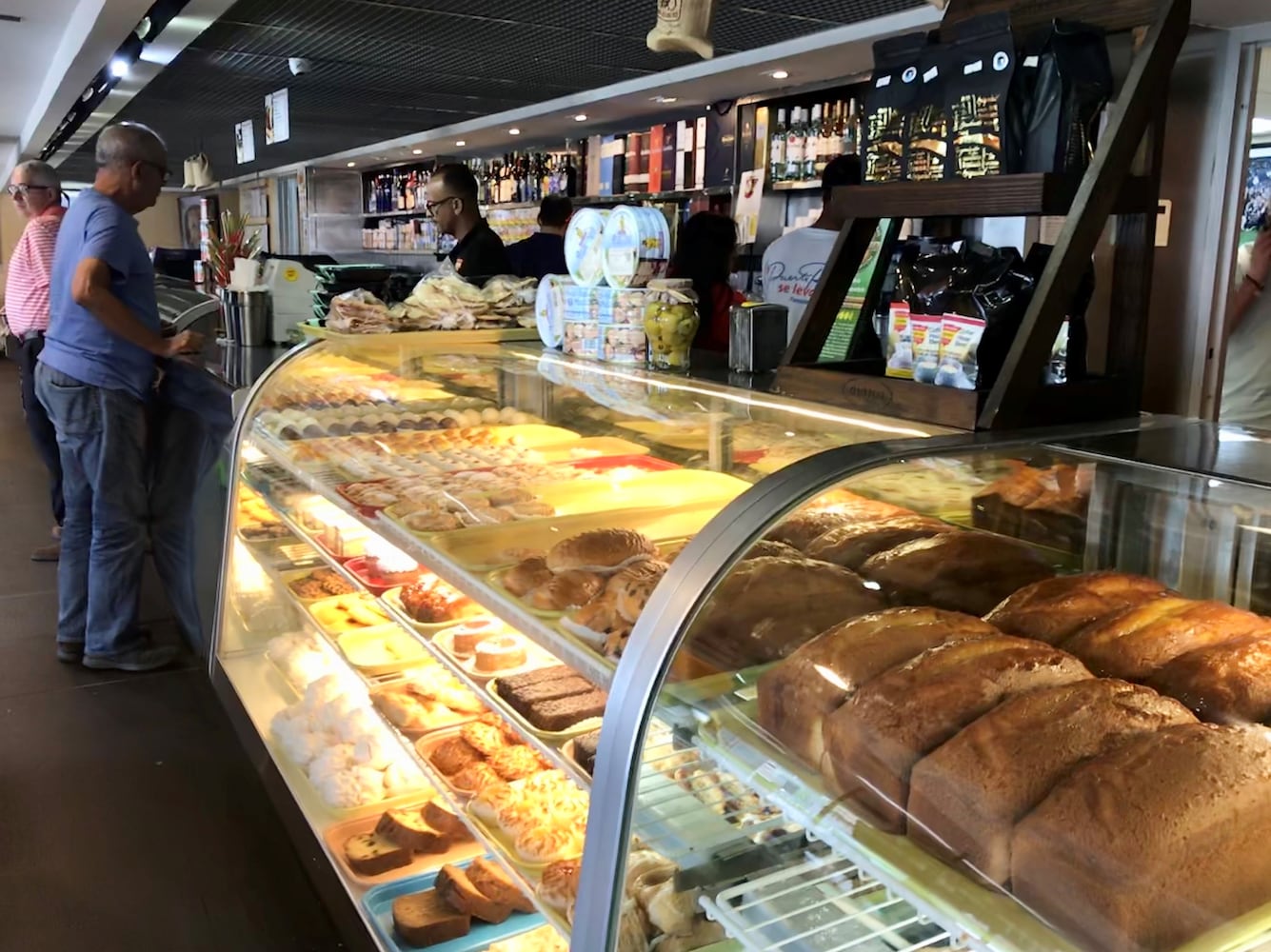Joe steered the rental car onto the gravel driveway. The cluster of two-story, concrete buildings looked like a ghost town. Downed palm trees lay on the rooftops. The grounds were littered with clothes, broken bottles and wooden slats from shutters ripped off windows. I stepped over a high-heeled shoe as I walked up the busted stairwell to the reception desk.
We were back.
I remembered the proprietress who tended to our every need during our honeymoon stay at this island parador in 1995. “They’ll be back,” she said to Joe and me as we watched a newlywed couple cancel the remainder of their stay because the wife wanted fancy resort pampering. The proprietress was right. The couple returned a day later. Caribe Playa, located on the island’s southeast corner in Patillas, had that kind of charm.
I tip-toed into what used to be the library, the 9-by-9-foot space that, to our surprise and delight on our honeymoon, doubled as a bar and movie room stocked with VHS tapes. Dusty books sat untouched in tidy stacks on the shelves. The rest was in shambles.
As we walked the shoreline of the property, we remembered the one photo we still have from that trip. We’re lying on the beach. Joe is holding a beer. We’re smiling like giddy schoolkids.
Just a few feet from where we took that photo, I found a weathered cardboard box in the sand. It was filled with Caribe Playa postcards, yellowed by the sun. The cards touted the parador as “an experience for the senses.” I took a few. Like a good funeral, it began to rain. So we left.
Puerto Rico is not the same as it was 23 years ago. It's not the same as it was even one year ago when hurricanes Irma and Maria swept through the island, leaving destruction in their wakes.
Joe and I aren’t the same either. The scars of life are visible in our graying hair, in the lines around our eyes and brows. There are invisible wounds, too, like the ache that began recently when our two sons moved out, one to college, the other to a different city and his first job. The house is too quiet for comfort.
Which is why we needed to go back. Near ground zero for Hurricane Maria’s landfall, Caribe Playa is no longer in business, but that didn’t mean we couldn’t create new memories on the Isla del Encanto.
We’d done just that when we arrived in San Juan a day earlier. There was a morning beach walk with a dip in the water as we watched tower cranes hoist heavy loads, part of the ongoing recovery work in the tourist district of Isla Verde. There was the café con leche, pastries and ham and cheese sandwiches at Panadería España, as much a social center as it is a bakery, bar none.
We pretended we were millionaires as we explored the Condado Vanderbilt Hotel with its dramatic view of the sea from the stately lobby, its opulent pool and terraces, its Spanish revival architecture.
There I learned of some positive outcomes that emerged from the storm, and of the resilient spirit of a people determined to rebuild the territory.
“For three days, we weren’t sleeping,” said Juan Jose “JJ” Cuevas, executive chef of the Condado Vanderbilt. He recounted the harrowing experience of working at the hotel when the hurricane struck. Cuevas was charged with feeding the 200 guests and 100 employees hunkered down during the storm. In the days that followed, food ran low. The lack of electricity made communications impossible, so he got in his car to hunt down food purveyors, pleading with them to sell any produce they had.
Today the produce Cuevas orders from farmers is vastly different from what was available one year ago.
"The farming is 100 percent better than since the hurricane," Cuevas said. Cash crops like yucca and plantain form the basis of the diet in Puerto Rico. The storm, however, prompted numerous farmers to plant fast-growing crops not typically found in traditional Puerto Rican cuisine: organic carrots, beets, collards, radishes, pea shoots and multiple varieties of beans. It has proved to be a boon to Cuevas' menu at the hotel's farm-to-table 1919 Restaurant.
Before we left, Cuevas pointed us in the direction of Puerto Rico’s chinchorros. Dotting roadways on the coast and in the mountains, chinchorros are places where you can pull over to get a cheap bite and a refreshing drink. As we rounded the bend on Carretera 187 near Loíza, a bonanza of options opened up. Shack after shack after shack offered empanadillas, fried turnovers, chicharrones (pork cracklings) and mofongo (mashed green plantains) that’s even better as “relleno,” packed with seafood or meat. Will you pair it with local Medalla beer or fresh juice? Neither for Joe, who opted for a piña colada.
With Caribe Playa in ruins, I hunted down the next closest parador, MaunaCaribe, in the town of Maunabo, a few miles east of Patillas. On the way to our cabana, we passed the pristine pool. It overlooked the Caribbean sea with crashing waves. I couldn’t change into my bathing suit fast enough. The air was a perfect 84 degrees. There was a perfect breeze. The sky and sea were a perfect blue. It wasn’t Caribe Playa, but it was perfect.
The next day found us driving along the southern coast. We stopped at Villa Pesquera beach in Patillas. Thirst brought us to a chinchorro there. I asked a couple if they would mind taking our picture. The wife happily obliged, then invited us to sit down with them.
“It’s his birthday,” she said, pointing to her husband. He smiled. His Bob Marley-branded straw hat made me smile.
Tita and Edwin were on their way to MaunaCaribe for a weekend stay. It’s hurricane season and the hotel didn’t have many guests. What were the chances?
"We lived for three months without electricity," Tita said about post-hurricane life in their hometown of Caguas in the central mountain range. She scrolled through pictures on her phone to show me her makeshift cooking setup and her neighbor's fallen roof. She reminded me that electricity had been slow to return to the island. A week earlier, she and Edwin had visited a Maunabo restaurant that was still without power. She spoke of the shame she felt when President Donald Trump visited the island last October and threw rolls of paper towels to the crowd of survivors at a relief center. She spoke in hushed tones about the true casualty count: nearly 3,000, according to a new study by the Milken Institute School of Public Health at George Washington University. The previous official tally was 64.
Not all the talk was bleak. Tita glanced over at her husband swinging on a hammock he’d hung between two palm trees, his hat was pitched over his face. He’d used a plastic toy shovel to clear away the seaweed and planted a colorful umbrella in the sand. She was looking forward to joining him in retirement later this year and to visiting their daughter, who serves in the Air Force and is stationed in Texas. In their current semi-retired state, the couple heads to places like MaunaCaribe one weekend a month.
It was time to explore more of the island. We headed westward toward Ponce, a Colonial city on the southern central coast. On our honeymoon, we gambled at a casino there, came out $25 ahead and promptly squandered our loot on a couple of cocktails. Ponce is also where I tasted my first mango. The sweet juices ran down my chin and arms, staining my salmon-colored wrap skirt. Oh, the joy of tropical fruit in its prime.
On our return trip, we stayed at the Hotel Bélgica, in operation since 1872 and a stone’s throw from the town square. I plunked down a bit extra for a room with a balcony and now stood on the narrow balcony and pretended to be Evita. My Juan Perón husband dutifully snapped a photo from the street below.
Our coffers weren’t as fat as those of the former first lady of Argentina, so we hit up the discount shops on Atocha walkway in search of sandals and island wear. We soaked up culture at the Museo de Arte de Ponce with its superb collection of baroque art. We walked the beachfront and watched a family toss sardines to foot-long Caribbean carp teeming in the waters of the Ponce Yacht and Fishing Club.
On Sunday, we sat inside the Cathedral of Ponce. Each of its massive wooden doors were propped open, but cross breezes never came. The loud whir of fans at times drowned out the somber words of the priest as he tried to assure the congregation that the Diocese of Ponce would not be affected by the Archdiocese of San Juan’s failure to fund $4.7 million in schoolteacher pensions. (A few days later, the archdiocese would file bankruptcy.)
As we passed by the cultural center, an artist beckoned us inside. He showed us a post-Maria painting of his neighborhood that was both sad and hopeful. Dark brush strokes rendered the houses as mere shadows, but there was a gray light that spoke to a coming dawn. It reminded me of a story chef Cuevas told me about a remote mountain community that found itself isolated when Hurricane Maria destroyed a bridge leading out of town. Ingenious residents built a rope bridge, rigged a shipping container on it and pulleyed this lifeline back and forth. “We as a country are together, very tight,” Cuevas said. “To survive, you do what you have to do.”
Puerto Ricans are living in a new normal, one that is simultaneously beautiful and bittersweet. I won’t forget their tales of surviving the strongest storm to hit the U.S. territory in 85 years, just as I won’t forget the beautiful yet bittersweet moments Joe and I created there together without our kids. The ritual of drying our clothes and shoes on the clay tile porch of our cabana. The bickering about each other’s driving capabilities while navigating pothole-riddled roads. And I won’t forget sitting alone on a cushion of palm branches, lost in thoughts about our past and present, not sure if they were worth writing in my notebook or just tucking away in my heart as we plod forward in our own new normal.
Travel tips
No passport necessary. Puerto Rico is a commonwealth nation, so U.S. citizens aren't required to go through customs or present a passport upon arrival or when departing for the U.S.
Cash is sometimes king. Visa and MasterCard are widely accepted; American Express not so much. But it's a good idea to bring cash, and in small denominations for tipping and visiting restaurants outside San Juan.
No hablo español. Puerto Rico has two official languages: Spanish and English. You do not have to speak Spanish to enjoy your time on the island. In general, locals in larger cities speak English more readily that those in small towns.
Driving around. Puerto Rico is 100 miles east to west, and 35 miles north to south, so renting a car enables you to explore more than the capital city of San Juan. Although electricity has been restored to residents, not all traffic lights are functional, especially in smaller communities. Proceed with caution; drivers do not always treat them as a 4-way stop. When driving on highways, the left lane is not considered a dedicated passing lane and slow drivers do not necessarily stay to the right. Road signs are in Spanish.
Packing up. All passenger baggage traveling from Puerto Rico to the U.S. mainland is subject to inspection by the USDA's Animal and Plant Health Inspection Service. Find a list of agricultural items permitted and prohibited into the mainland at aphis.usda.gov.
WHERE TO STAY
Hotel Bélgica. 122 Calle Villa, Ponce. 787-844-3255, hotelbelgica.com.
Parador MaunaCaribe. Panoramic Road 901 Km., 1.9 Bo. Emajaguas, Maunabo. 787-861-3330, tropicalinnspr.com.
RELATED:
About the Author
Keep Reading
The Latest
Featured
